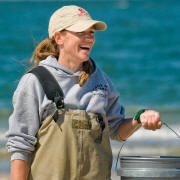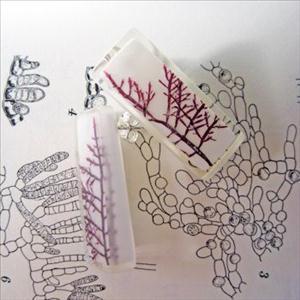MOREHEAD CITY — Abigail Poray has always loved nature and she always knew that wanted to pursue a career in the natural sciences. She became smitten with the ocean while studying in the Turks and Caicos Islands.
The idea of turning her vocation into something pretty came to her soon after.
Supporter Spotlight
It was 2008, and Poray was at California State University in Northridge working on a master’s degree in the study of all seaweed, including algae. She realized that not only was algae interesting, it was also colorful and should be more than something pressed between two microscope slides and then thrown in a binder. It could be turned into jewelry.
In no time it became a passion. Poray began expressing her appreciation of the organisms in the form of beautiful one-of-a-kind jewelry.
 Abigail Poray turned her vocation into art. |
“In grad school we had to take a class in the study of algae. I loved the layout, color and forms and wanted to preserve them and use them. I wanted to blend science with art,” she said. “I saw someone use resin to cast wildflowers and thought ‘why can’t I do that with algae?’”
On her website she describes why she loves the algae so much, “Algae create beautiful and ecologically healthy underwater gardens, full of life and grace. Through my work I hope to open up a world unknown to most people and help develop a greater appreciation for what nature can create.”
Algae from California, Japan and North Carolina can be found in her various pieces of jewelry and come in various shades of brown, green and red. But most of the material she works with is collected off the coast of North Carolina, from shallow intertidal areas to deep offshore habitats.
Supporter Spotlight
“The browns and greens are found inshore, but I have to dive for the reds,” Poray explained.
Many of her friends give her algae that they have collected throughout the world. It can come in the form of a piece wrapped in a paper towel or they may give it to her already pressed, but she likes to ensure that each piece is identified as to species and where it was harvested.
Her desire is for everyone who gets her jewelry can also learn to appreciate algae for its beauty and not just associate it with the slimy, gooey stuff that grows on the insides of aquariums. She attaches each piece to a card with the identification information.
 The earrings are made from a species of gelidium, an algae found in shallow estuaries around the world. Photo: Abigail Poray |
 This pendant is made from a species of egregia, a family of kelp. |
“I feel like that is a really neat thing about it, but occasionally I’ll get a customer who tears the tag right off and hands it to me to throw away or reuse,” she said.
Poray says she has improved quite a bit since she cast her first pieces of algae jewelry. She currently casts pendants and earrings and is working to create a bangle or cuff bracelet that will also convert algae into wearable art. She is also considering making notecards with prints of her unique collection of algae.
The process to make the jewelry involves collecting and making pressings of the various algae and then searching her files for the perfect pieces to incorporate into her jewelry. After she chooses the piece of algae, she lays a thin layer of resin in the bottom of the mold. The algae are placed on top of that and then another layer of clear or pigmented resin is laid on top of the algae. The jewelry is sanded and put back into the mold to add more resin to seal the edges and keep the air and water from getting to the piece of algae. She said she learned from her earlier pieces that if she didn’t add the last layer of resin, the algae would not hold up as well. She also uses silver with each of her pieces and pendants can be purchased with coil wire, omega chains or cords.
The pendants and earrings really have to be seen to be appreciated. Some of the pieces of algae look like miniature coral while others look like a miniature scene with giant trees and tiny people. Poray says part of the fun is looking at each piece of algae and imagining how it will look as a piece of art jewelry.
Each piece of unique algae jewelry takes about an hour and a half to produce—not including the drying time. They range in price from $35-$60. “I want people to wear these so I want them to be affordable, but at the same time I want it to be worth my time. I would really like this (business) to eventually be something that can support me.
Poray also works as lab manager for the Fisheries Ecology Lab at the UNC Institute of Marine Sciences in Morehead City.
Poray sells her jewelry at Handscapes Gallery in Beaufort and on her web site. She hopes to someday be able to sell it in more stores, but because it is so labor intensive she can’t keep up with the demand by herself. She also works on consignment and is completing jewelry for two upcoming weddings.
“The brides are friends who appreciate my work,” she said.
That is also an important factor in selling the pieces. “Not everyone appreciates that these are one-of-a-kind pieces of art and not just jewelry,” Poray said.
However, the people who see it in person find it unique and interesting, according to owner Alison Brooks at Handscapes Gallery. “People are very impressed with Abigail’s jewelry because it is unusual for one reason,” she said. “No one has ever seen algae jewelry before. Also it is locally collected and is a beautiful presentation, so it is unique, local and representative of the area.”








